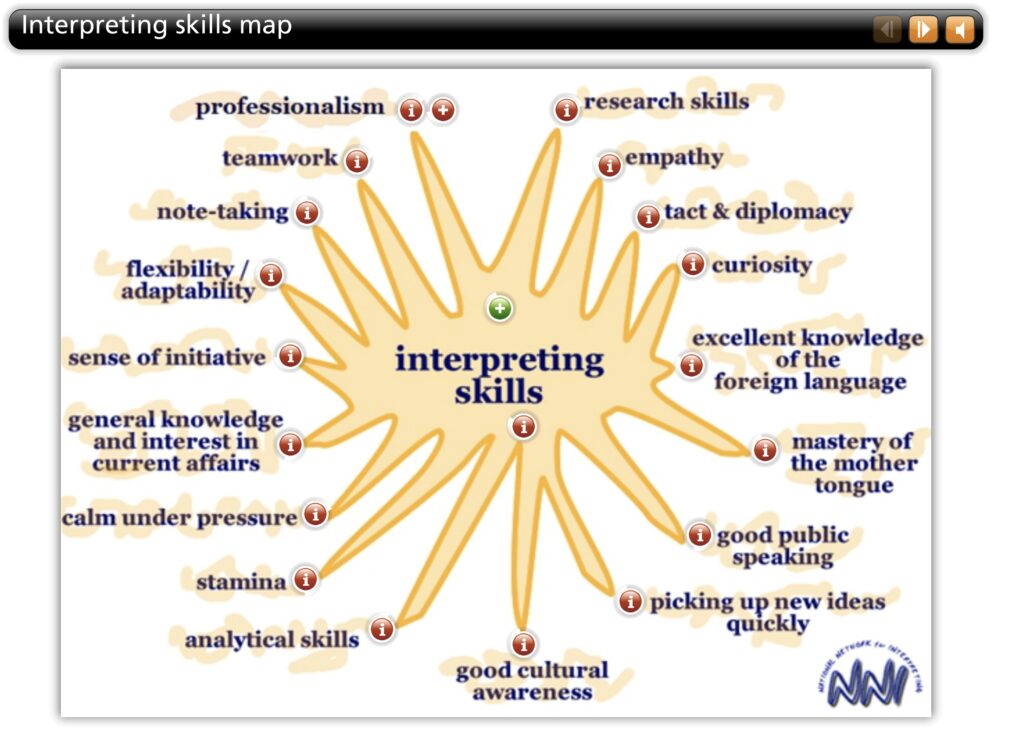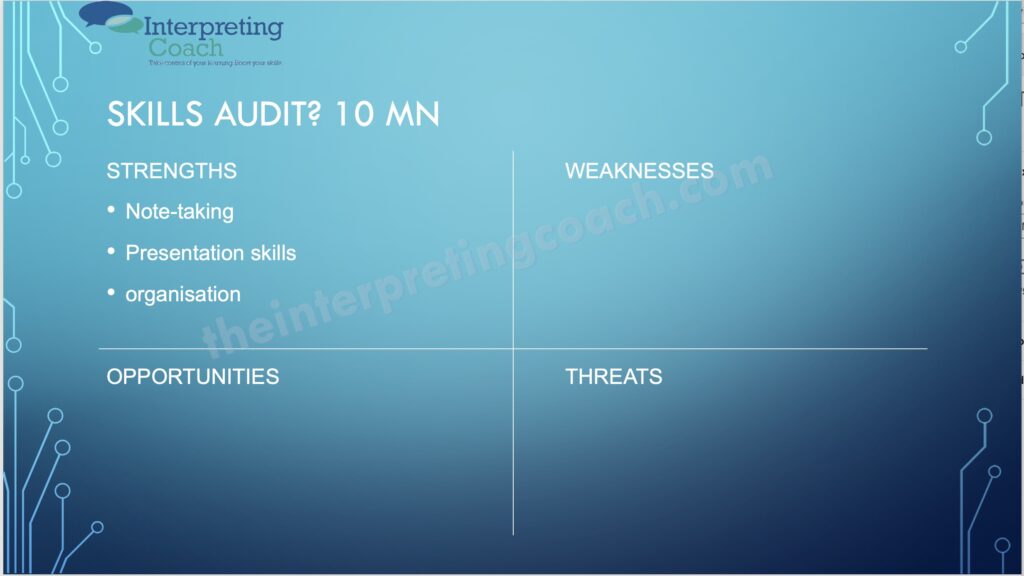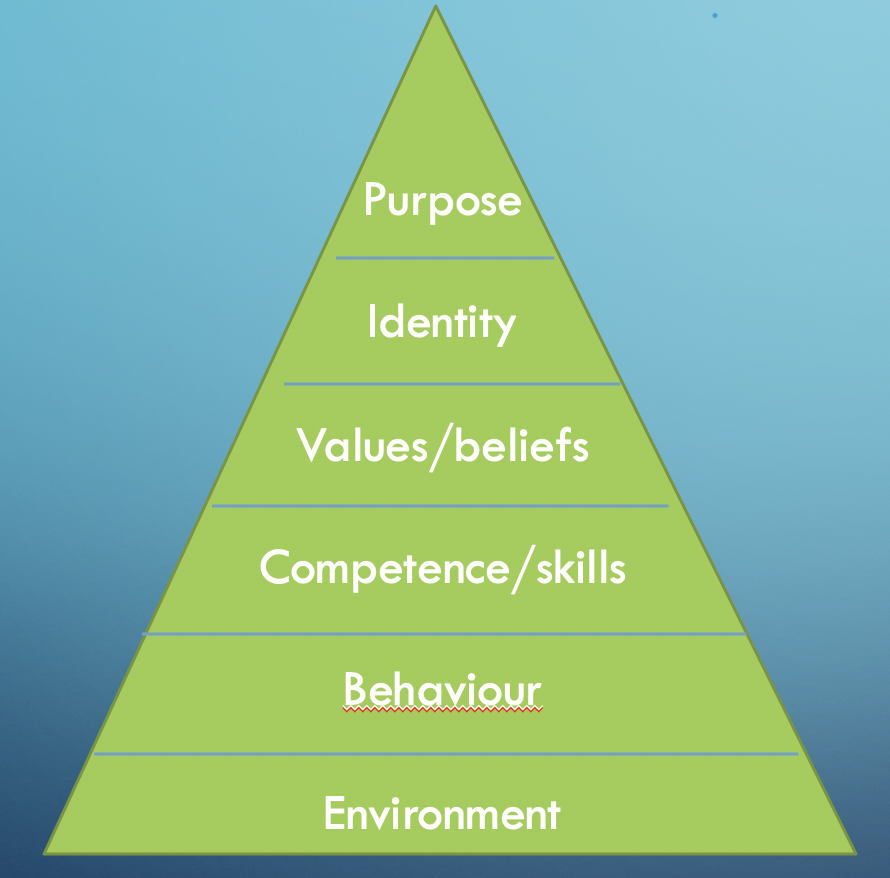CPD = lifelong learning
So, you’ve just taken your final year interpreting exams, and you’re looking forward (hmm…) to entering the brave new world of post-coronavirus conference interpreting.
But your skills aren’t 100% up to scratch yet. Perhaps you need more practice in simultaneous. Or you’re thinking of adding another passive language. Or you’re totally stressed about your…stress management strategies. Or you need to learn more about Remote Simultaneous Interpreting platforms because…well, let’s not go down that rabbit hole.

The point is, all of this comes under the umbrella of CPD, or Continuing Professional Development.
Maybe you’re not a recent graduate. If you’re reading this, you’ve likely already discovered that lifelong learning means just that. It. Never. Ends. There is always more to learn. And that is definitely the case for interpreters.
But what? How? When? And even: what for?
In this blog post, I aim to help you get more clarity about your CPD needs and how to achieve them. If you’d rather listen than read, click for my dulcet tones (ahem) in your ear.
I’ve also produced a workbook for you. If you take the time to go through it and fill it in, you’ll have a solid plan that will see you through years of CPD.
CPD is the intentional maintenance and development of the knowledge and skills needed to perform in a professional capacity.
CPD is sometimes a legal requirement in order to practise a particular profession or obtain insurance. In Italy, for example, a certain number of CPD hours per year is a compulsory requirement for interpreters.
Even if evidence of CPD is not a legal requirement, it may be a compulsory condition of membership of your local professional association.
And beyond that, CPD is also about being the best interpreter you can be and setting yourself the highest possible standards.
CPD – key points
The definition I’ve given above contains a number of key ideas.
- ‘intentional’: CPD is self-directed, i.e. it’s up to you to identify your needs. Unlike a university course with a set list of modules, when it comes to continuing professional development, you need to diagnose your weaknesses and lacunae and come up with a plan (perhaps with some help).
- ‘maintenance and development’: maintenance is a minimum, so you can keep doing your job properly. It would be nice to think that once you’re qualified, you’re done. But we all know that note-taking skills get rusty, and if you don’t do simultaneous for a few days or weeks, you’re no longer match fit. So the bare minimum when it comes to CPD is having a plan to keep your interpreting skills and relevant knowledge up to standard. Development is what will allow you to progress in your career: take on new assignments or work in new markets (because of new expertise, a new passive language, a ‘retour’), or get promoted.
- ‘knowledge and skills’, ‘perform in a professional capacity’: interpreting isn’t just about technical skills (sight translation, note-taking, salami technique…). To be a professional in this field, you need all sorts of other skills and expertise (for example, networking and marketing to help you find clients and stand out in a crowded market).
A final point: the great thing about CPD isn’t that it isn’t rigidly defined. There are all sorts of things you could do to enhance your development, some formal, others informal. Alongside courses, workshops, webinars, and communities of practice, you could also find a mentor, shadow a more experienced colleague at work, read blogs or research papers, watch videos online, play language games, join a debating society, and more.
Defining your goal
You can only define your CPD needs if you know what your goal is, so your goal should be your starting point.
Are you hoping to work as a freelance interpreter for the UN? For NATO? Are you biactive and hoping to break into a local private market? Your needs will be quite different. For UN work, you’ll need specific passive languages, a strong grasp of geopolitical realities, and the ability to deal with very fast simultaneous and simultaneous with text. For NATO, your B language will have to be nearly on a par with your A language. To work on certain local markets, you’ll need to be good at marketing yourself and networking.
Here’s what you need:
- A vision of where you want to be and why (what country – one where your A language is rare, hence an asset; or a country that will help you develop your B language, or improve a C language? What type of interpreting: conference, or public service interpreting? Private market, or international organisations? Translation and/or other work as well, e.g. teaching, subtitling?). Remember that the answers to these questions will change, which is why you need to review your goals every so often.
- A good understanding of the skills you need. Does your ideal interpreting job require consecutive or not? Do you need specific IT skills? Must you be able to use a certain type of software?
- A clear idea of the standard and how far you are from achieving that standard. Do you know what standard is required in order to pass an EU accreditation test, if that is your ambition? If not, you need to find out.
- A list of priorities. You can’t address all your weaknesses at once.
Take a few minutes to think about questions 1-3, and jot the answers down on a piece of paper – or use my workbook . Read on to find out more about defining, refining and prioritising your CPD needs.
Defining your CPD needs
The exercise I’ve just asked you to do was intended to help you identify what you’re aiming for, and what is required to fulfil that ambition.
Now you need to work out how much of a mismatch there is between those requirements and your existing skills and knowledge.
I like to think of all the elements that make up a top-notch interpreter in a very visual form, using a mind map (some of you may call it a spider diagram).
Here’s an example from the National Network for Interpreting website.

I talk through the skills map in more detail in this video:
Time to get down to the nitty gritty!
Sharpen your pencil, get yourself a cup of tea (or a latte, or whatever floats your boat), and get your thinking cap on, because it’s time for a skills audit.
Skills audit
Have you heard of SWOT analysis? It’s an approach often used in business, to determine the a company’s strengths, weaknesses, threats and opportunities, and then to decide on a plan in the light of these insights.
A SWOT analysis, also known as a skills audit, is a very useful tool in your arsenal. It’s something I encourage interpreting students to do at the beginning of their interpreting course, and again a few weeks before their exams, so they can decide where to focus their efforts.
It’s also a very useful way of establishing your CPD needs.
Divide your page into four, and write down the four headings: strengths, weaknesses, threats, opportunities. Like this (or follow along in the workbook):

I’ve put some examples in the ‘strengths’ column, just to give you an idea. Obviously this is a very personal exercise.
Think about the interpreting skills mind map (which you can of course break down into even more detailed skills; for example, for public speaking, you could consider pronunciation, intonation, ‘ums’, fillers, eye contact, etc.), and try to classify these skills as strengths or weaknesses of yours, in the light of your ‘vision’ – i.e. where you want to work, for whom, and what standard is required.
Perhaps public speaking is one of your strengths, but stress management is not.
Perhaps you are a people person, and very good at networking, but you’re a bit chaotic and you need to work on business skills and being more organised.
Write it down!
Then think about those factors that are external to you: the threats to your development, and the opportunities. Again, these are very personal.
Your threats might include lack of money, or family obligations that mean you can’t travel, or lack of equipment (headphones, or a laptop), or Brexit.
Your opportunities might include willingness to travel, or a partner who speaks one of your passive language, or good contacts in the industry.
Make a note of everything.
Spend a few minutes thinking about how you can use your opportunities and how you can minimise your threats.
Now we’re going to focus on your weaknesses, because these are your CPD needs, i.e. these are the areas of skill or knowledge that are ripe for development.
Refining your needs
It’s one thing to know what you need to improve (i.e. your weaknesses), and it’s another to know how to improve them.
What course would best suit you? Should it be intensive or spread out? Would you be better off working alone or with a coach?
Sometimes the answer isn’t as straightforward as you think.
I’ll give you an example. My daughter is really good at maths, and she loves it. But when she sees a question type she’s never tackled before, she gives up immediately, wailing that she doesn’t know how to do it, and often bursting into tears. This is not a skills problem, it is a mindset problem. There is little point getting her extra maths tuition when she knows the answers already. What she needs is an approach that will boost her confidence and help her develop problem-solving abilities and a growth mindset.
So now that you’ve identified your weaknesses, you need to examine them in a way that will help you determine how to tackle them.
To do this, one approach I find useful is Dilt’s logical levels (from neuro-linguistic programming, if you’re interested).

If you want to make changes in your life (in this case, improving your skills or knowledge), you need to understand at what level you’re operating. Often, the way you talk about these challenges will give you hints.
For example, if you say ‘I don’t do enough interpreting practice, because my office is so cluttered and I keep getting interrupted’, this is an environment problem, and the environment is what you need to fix!
If you say things like ‘I don’t really have time to work on my retour’, or ‘I’m always meaning to listen to podcasts, but I have so many other things to do first’, this could be a sign that you are procrastinating, and you need to find strategies to address that behaviour.
Phrases like ‘I don’t know how to do this’, ‘I’ve never done simultaneous’, ‘I’ve just been asked to teach online and I’ve never done it before’, ‘I haven’t done consecutive for five years’, sound like a skills gap, which can be addressed at the level of competence – you can find a course, workshop, coaching opportunity, etc.
On the other hand, if you say something like ‘I find sight translation really difficult’, or ‘I hate dealing with numbers’, ‘or ‘I’m really bad at consecutive’, this could either be a skills gap or a mindset/confidence issue.
And if you’re saying things like ‘I can’t be bothered to do this’, or ‘I don’t see the point of this for me’, or ‘interpreters shouldn’t be asked to do this’, this is a reflection of your beliefs or values, and you will have to examine those before deciding whether you need further training.
Phew! Bet you didn’t realise that CPD would involve so much soul-searching, right?
You’re nearly there, though. And remember, you can use my workbook to guide you through this process.
OK, your final step is to prioritise your needs.
Prioritising your needs
This should be relatively quick, now that you have laid all the groundwork.
• Think about your lacunae in the light of Dilt’s logical levels, to help you understand how to tackle them.
• For each weakness, ask yourself: how important is this to me? How essential is it to develop this competence now? Remember, you can’t do everything at once. Some skills may need immediate attention because, say, you’re applying for a job right now.
• Distil your CPD needs to 4 or 5 key skills or areas of knowledge.
Planning your CPD
Reflect on how to get from A to B. You’ll need to a) do some research, to find out what’s available in terms of workshops, courses, practice groups etc. that might meet your needs, and b) consider how much time you have available.
Make a list for each of your 4 or 5 key areas.
There’s an increasing array of CPD options available for interpreters. I won’t list them all here, because they won’t all be relevant to you, but you can have a look at this free list if you happen to be a recent graduate with mainstream European languages, and your ambitions involve working on the conference or institutional market in Europe. I’ve listed various volunteering, internship, and networking opportunities, as well as online resources for conference interpreters, such as course and webinar providers.
Reflective practice
…but it’s not all over!
The value of reflective practice in an educational setting and in the workplace is increasingly recognised.
It’s also important to keep a record of your CPD efforts in case you ever need to provide an employer or professional association with evidence of your learning.
For this reason, I highly recommend keeping a combined learning journal and portfolio of your CPD work.
You can find an example – guess where? – in my workbook , but the idea is fairly simple: note down the date of any CPD activity you engage in, the provider, the type of activity (remember, this doesn’t have to be a formal course. It could be reading in your own time, or contributing an article to a publication, or doing outreach work). Write down what you found useful about this activity, how you will apply it in practice, or what you would do differently next time.
| DATE | ACTIVITY | PROVIDER | WHAT WAS USEFUL? | IMPLEMENTATION | NOTES |
| 01.01.2020 | webinar | AIIC | |||
| 15-21.06.2020 | WISE workshop | peer group |
To flesh this out into a portfolio, keep a note of your needs and goals on the first page, and review these regularly (say, every 6 months or annually). Also keep copies of any certificates you obtain after attending CPD courses.
Two key areas for development
I’ll wrap up with a couple of areas I think are increasingly important, given the situation on the interpreting market, and also the way the world has developed in the past twenty years or so. I’m venturing beyond the narrow limits of interpreting skills here, into other skills and areas of knowledge.
Business skills
Newcomers to the interpreting market need to be much more professional in how they present and market themselves these days, I think. More and more, language professionals are running a language business, and they need the right skills to allow them to do so.
I won’t go into detail here. Just think about where you are with regard to the following:
- Administrative procedures for freelancers in your country, including health insurance, VAT, pension arrangements
- Business skills such as accountancy, invoicing, client management
- Making sure you have the right equipment, including a laptop or tablet, headphones, jacks, webcam, etc.
- A solid and visible business presence, including a good, up-to-date CV, business cards, a permanent (professional looking!) email address, and possibly a website
- ?Preparing for remote interpreting. Are you intending to go down this road? What extra skills do you need?
- Marketing: in a crowded market where interpreters are often treated as commodities (and don’t get me started on working conditions during the COVID pandemic…), you need to understand your value as a skilled professional. You could consider a seminar such as Julia Poger’s Know your Worth.
Health and wellbeing
Interpreters have very specific needs when it comes to health and wellbeing. The very sedentary nature of our work, the increasing use of computers and screens, and the stressful aspects of interpreting, should lead you to try to establish good habits from the start.
Here are a few key areas to think about:
- having an ergonomic office set-up (height of chair, distance from screen, etc.)
- eye strain
- hearing. Amid increasingly frequent reports of acoustic shock, it’s important to have regular hearing tests.
- voice. Your greatest tool as an interpreter. Look after it!
- general health (nutrition, exercise). Conference interpreters are prone to back problems: we spend too much time seated, and our position isn’t always ergonomic.
- stress management. I could say all sorts of things about this (and I often do, in seminars and webinars), but I’ve already written thousands of words in this blog post, so I’ll keep it short. Different approaches to stress work for different people, so try to find what works for you. If you’re looking for a short course with a holistic approach, that covers the basics of relaxation, meditation, and nutrition, try Gabriela Bocanete’s course, which involves delightful Yoga Nidra sound baths.
Enjoy it!
OK, that’s enough! That’s it!
CPD can be fun: it’s satisfying, because you’re learning something and opening up new career opportunities, but it’s also a great way to meet new people, make friends, and feel connected to your ‘tribe’.
Good luck!
Learning through reflection: the critical role of reflection in work-based learning (WBL)
Ruth Helyer, Journal of Work-Applied Management, ISSN: 2205-2062. Publication date: 6 October 2015

Sophie Llewellyn Smith, writing as The Interpreting Coach, is a coach, interpreter trainer, conference interpreter, designer of online teaching materials, and creator of Speechpool. Follow the blog to pick up tips on how to improve your interpreting skills, and check out the website for digital material to complement your face-to-face learning and empower you to take control of your learning. If you’re interested in personal coaching, why not book a free discovery call?


hi i was wondering if someone could help me with my part one interpreting assignments
Hi Shahima, I don’t think you’ll get much response to your request here. Do you have a practice partner? A classmate who could help? Or tutors who could point in the right direction?